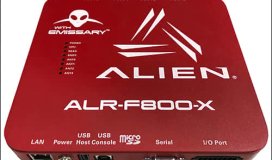PINC, an unmanned aerial vehicle (UAV) technology company, has begun powering its drones with air-cooled fuel-cell systems provided by Intelligent Energy as an alternative to batteries, in order to offer lower-weight, longer-flight-time solutions that have less impact on the environment. The fuel cells will help enable the use of drones indoors to track inventory and other details about products in the tight quarters of a warehouse.
Since 2004, PINC has been providing real-time location and yard-management solutions. In 2014, the firm introduced cycle-counting drones (also known as aerial robots) that fly through an area, such as a vehicle or trailer yard in manufacturing plants and distribution centers, and use ultrahigh-frequency (UHF) radio frequency identification technology to capture tag reads and confirm the location of inventory based on those reads. The company provides an automated way to collect inventory data on a daily basis. PINC often offers the solution with other technology as well, such as optic functionality to capture images or video of the conditions of vehicles, trailers and containers.
The company considered itself a tool for outdoor yard management only, says Matt Yearling, PINC's president and CEO, but customers had expressed a growing need for solutions at their facilities. "Some of our customers had said they were having issues [with inventory tracking] indoors," he says.
These customers tend to be large businesses with potentially a million square feet of indoor space. Companies found that inventory accuracy indoors was not always as accurate as they believed it to be. "We looked around," he states. "We thought the warehouse-management system players would have been addressing these problems." However, he says, customers found no such solution. PINC is now delivering its solution indoors as well, with autonomous drones specially designed to locate and count inventory for use inside buildings.
But the use of indoor drones raises complexities, Yearling notes. They must be able to operate autonomously. They need to be small and nimble enough to navigate narrow aisles without requiring battery recharges several times before completing a single inventory check. However, smaller drones with smaller frames cannot carry as many batteries, and because indoor use requires more computing requirements, they consume even more energy than the outdoor versions.
For that reason, PINC has launched its partnership with Intelligent Energy to build fuel cells into its drones. Fuel cells enabled the drones to operate significantly longer than they would with a standard rechargeable battery. What's more, Yearling says, they are quiet and only produce water vapor as a waste product.
Fuel cells combine oxygen with hydrogen to trigger a chemical reaction that creates energy, explains Julian Hughes, Intelligent Energy's senior VP. While a battery stores energy, the fuel cell produces power until it exhausts its supply of hydrogen, at which time it must be refueled. The refueling process, Hughes says, typically takes just a few minutes.
Intelligent Energy has now developed an air-cooled fuel-cell system for drones.
PINC reports that it already has eight pilots under way involving indoor drones flying through distribution centers—several of which are nearing completion, with permanent deployments now being prepared. Some employ batteries, but are now testing the use of fuel cells.
"All large companies are looking at drone technology," Yearling says, "and they have multiple use cases. It's not all about supply chain [inventory tracking]." He says retailers, manufacturers and logistics providers are all at least testing the use of drones to capture inventory data, look for damage or changes to inventory, and accomplish other tasks, all with a single drone.
In the case of inventory tracking outside of a warehouse, automobile manufacturers and other companies are applying RFID tags to finished vehicles. As such, drones can capture each tag's ID number as it flies overhead during a daily inventory count.
Thus far, Yearling says, most of the outdoor drone-based solutions that PINC offers use RFID and optics technology for inventory location and counts, while optical technology is being used indoors. Optics also allow users to view finished vehicles, and to pull up images of interest to see the results of the assembly work.
The use of fuel cells, Hughes says, may make regular inventory via drones more realistic for large companies that need the power per flight that would keep the drone in the air until the entire inventory count can be completed. "I think it helps enable the use of drones in DCs and warehouses, where the inventory needs to be inspected daily or twice daily," he states. "The additional flight time on the drone will save a huge amount in lost inventory. We are talking to a number of industries where extended flight time is important."
More info visit rfidjournal.com



